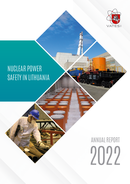VATESI has published Annual Report 2013. In this report you can find information about VATESI activities related with nuclear and radiation safety also physical security issues in Lithuania.
Nuclear Power Safety in Lithuania. Annual Report 2013 (pdf)
During the Lithuanian Presidency of the Council of the European Union, the Working Party on Atomic Questions started discussing proposals of the European Commission of amendments to the Nuclear Safety Directive (2009/71/Euratom).
Another area of critical importance and relevance was strengthening national nuclear security by focusing the special attention and effort of all Government authorities on targeted and intense cooperation to exchange information on potential illegal activities against the existing and future nuclear facilities, and storing of nuclear or radioactive materials. In order to have stronger cooperation and information and practice exchange in the area of nuclear security, in 2013 VATESI joined the European Nuclear Security Regulators Association (ENSRA), which currently unites 15 authorities regulating nuclear security in Europe.
After the European stress tests and peer review of their results, in 2013 VATESI approved the Plan for Strengthening Nuclear Safety, which sets forth safety upgrading measures to be implemented at the closed Ignalina Nuclear Power Plant (NPP) and the spent nuclear fuel storage facility that is under construction. Participating in the review process is important, as is the possibility to share experience and assess lessons learnt after the accident at the Fukushima Daiichi Nuclear Power Plant in Japan thus improving the security of existing and future nuclear power plants in Europe.
Other main areas of activity in 2013 were supervision of nuclear and radiation safety at Ignalina NPP, which was finally shut down, supervision of safety during the decommissioning, and radioactive waste management, including the construction and operation of new nuclear facilities.
In 2013, 6 unusual events were registered at Ignalina NPP. During these events the level of occupational exposure of Ignalina NPP employees and contamination of the premises with radionuclides did not exceed the permissible limits, and radionuclides were not released to the environment.
Also In 2013 the Final Safety Analysis Report of the Very Low-Level Radioactive Waste Storage Facility and technical design amendments were evaluated, a licence to operate the facility was issued, followed by the issue of its commercial operation permit after the so-called “hot tests”. A technical design for a Very Low-Level Radioactive Waste Repository was also approved. Evaluation of the Technical Design of Unsealed Spent Nuclear Fuel Management started; evaluation also began on documents of the Preliminary Safety Analysis Report.
During 2013 there were 43 inspections of economic entities. Most of these inspections were carried out at Ignalina NPP, which was inspected 41 times. The state research institute Center for Physical Sciences and Technology was inspected once, and the State Enterprise Radioactive Waste Management Agency was also inspected once. It is important to note that no violations or inconsistencies were found which may have directly caused occupational exposure doses to be exceeded, deterioration of barriers confining radionuclides or suppressing ionising radiation, degradation of features of safety important devices, activity of radionuclides released to the environment exceeding limit values set forth in the Plan of Radionuclides Released to the Environment, or non-compliance with related safe operation conditions. Economic entities eliminated other reported violations within the time set forth in the binding instructions submitted to them.







